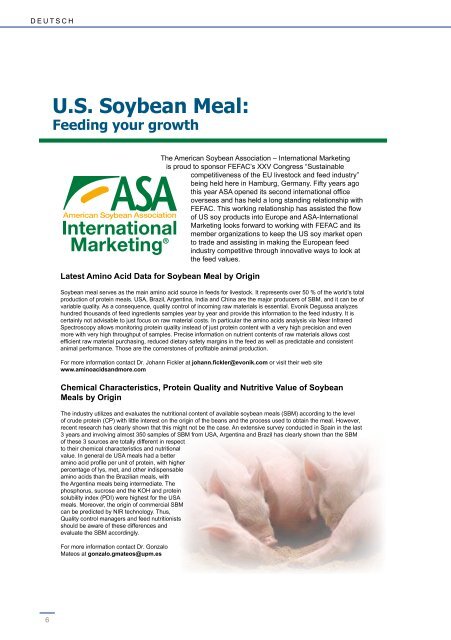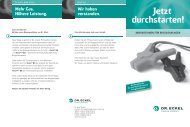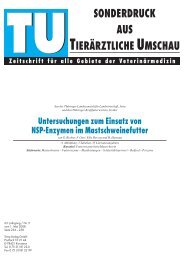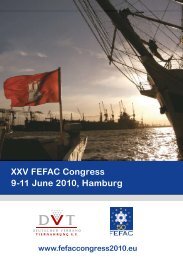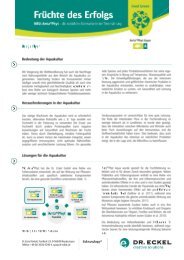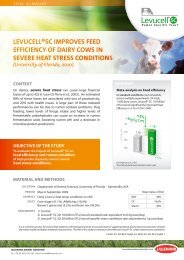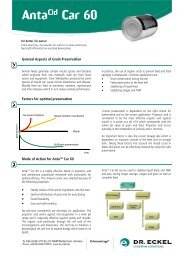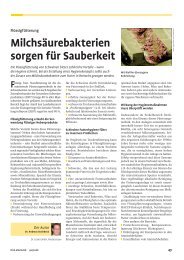XXV. FEFAC-Kongress 9.-11. Juni 2010, Hamburg - Dr. Eckel
XXV. FEFAC-Kongress 9.-11. Juni 2010, Hamburg - Dr. Eckel
XXV. FEFAC-Kongress 9.-11. Juni 2010, Hamburg - Dr. Eckel
Sie wollen auch ein ePaper? Erhöhen Sie die Reichweite Ihrer Titel.
YUMPU macht aus Druck-PDFs automatisch weboptimierte ePaper, die Google liebt.
Deutsch<br />
Deutsch<br />
U.S. Soybean Meal:<br />
Feeding your growth<br />
Latest Amino Acid Data for Soybean Meal by Origin<br />
The American Soybean Association – International Marketing<br />
is proud to sponsor <strong>FEFAC</strong>’s <strong>XXV</strong> Congress “Sustainable<br />
competitiveness of the EU livestock and feed industry”<br />
being held here in <strong>Hamburg</strong>, Germany. Fifty years ago<br />
this year ASA opened its second international office<br />
overseas and has held a long standing relationship with<br />
<strong>FEFAC</strong>. This working relationship has assisted the flow<br />
of US soy products into Europe and ASA-International<br />
Marketing looks forward to working with <strong>FEFAC</strong> and its<br />
member organizations to keep the US soy market open<br />
to trade and assisting in making the European feed<br />
industry competitive through innovative ways to look at<br />
the feed values.<br />
Soybean meal serves as the main amino acid source in feeds for livestock. It represents over 50 % of the world’s total<br />
production of protein meals. USA, Brazil, Argentina, India and China are the major producers of SBM, and it can be of<br />
variable quality. As a consequence, quality control of incoming raw materials is essential. Evonik Degussa analyzes<br />
hundred thousands of feed ingredients samples year by year and provide this information to the feed industry. It is<br />
certainly not advisable to just focus on raw material costs. In particular the amino acids analysis via Near Infrared<br />
Spectroscopy allows monitoring protein quality instead of just protein content with a very high precision and even<br />
more with very high throughput of samples. Precise information on nutrient contents of raw materials allows cost<br />
efficient raw material purchasing, reduced dietary safety margins in the feed as well as predictable and consistent<br />
animal performance. Those are the cornerstones of profitable animal production.<br />
For more information contact <strong>Dr</strong>. Johann Fickler at johann.fickler@evonik.com or visit their web site<br />
www.aminoacidsandmore.com<br />
Chemical Characteristics, Protein Quality and Nutritive Value of Soybean<br />
Meals by Origin<br />
The industry utilizes and evaluates the nutritional content of available soybean meals (SBM) according to the level<br />
of crude protein (CP) with little interest on the origin of the beans and the process used to obtain the meal. However,<br />
recent research has clearly shown that this might not be the case. An extensive survey conducted in Spain in the last<br />
3 years and involving almost 350 samples of SBM from USA, Argentina and Brazil has clearly shown than the SBM<br />
of these 3 sources are totally different in respect<br />
to their chemical characteristics and nutritional<br />
value. In general de USA meals had a better<br />
amino acid profile per unit of protein, with higher<br />
percentage of lys, met, and other indispensable<br />
amino acids than the Brazilian meals, with<br />
the Argentina meals being intermediate. The<br />
phosphorus, sucrose and the KOH and protein<br />
solubility index (PDI) were highest for the USA<br />
meals. Moreover, the origin of commercial SBM<br />
can be predicted by NIR technology. Thus,<br />
Quality control managers and feed nutritionists<br />
should be aware of these differences and<br />
evaluate the SBM accordingly.<br />
For more information contact <strong>Dr</strong>. Gonzalo<br />
Mateos at gonzalo.gmateos@upm.es<br />
The Economical Value of Digestible Energy and Amino Acids of Soybean Meal<br />
of different Origin in Modern Feed Formulations<br />
As a result of the research of Prof. <strong>Dr</strong>. G.G. Mateos (University of Madrid, Spain) matrix values of 4 different<br />
soybean meals of different origin were obtained. These differed in protein content and nutrient digestibility, resulting<br />
in differences in energy and amino acid content for pigs, layers and broiler. Via Least Cost Formulations of different<br />
feeds for these animal species shadow prices (= maximum price for inclusion) can be calculated and the value of<br />
SBM by origin compared for different feedstuff markets. Using feedstuff prices for the period February-April <strong>2010</strong> for<br />
North Western Europe it can be concluded that the value of soybean meal is only partly dependant on the protein<br />
content. Differences in energy and digestible amino acid content among SBM’s of different origin together account<br />
for as much of the differences in value for swine and poultry feeds as differences in protein content. The effects of a<br />
higher digestible amino acid content and more specifically energy content on the value of SBM is much higher for the<br />
US product with 50% protein than that with 48% compared to the<br />
product from Brazil and most pronounced in broiler feeds. The<br />
absolute value of SBM from the US is € 14.50-5<strong>9.</strong>00/ton higher<br />
than that of Argentina or Brazil depending on the animal specie.<br />
Learn More<br />
American Soybean Association – International Marketing<br />
Keizersgracht 62-64<br />
1015 CS Amsterdam<br />
The Netherlands<br />
tel: 31.0.20.520.7978<br />
fax: 31.0.20.520.7510<br />
For more information contact JDoppenberg@schothorst.<br />
nl or take a look www.schothorst.nl for services offered by<br />
Schothorst Feed Research<br />
Feed Formulation Exercises Show<br />
Opportunity Prices for Different Soybean<br />
Meals<br />
Feed manufacturers have the ability to leverage Brill<br />
Formulation® software from Feed Management Systems to<br />
analyze the ingredients you have available along with the<br />
nutrient values options needed to obtain the least-cost solution<br />
for a formula and the best diet for the animals. Different soybean<br />
meals are positively related with their composition and quality.<br />
Often the Soybean meal from USA origin has higher energy and amino acid content than the other SBM, and<br />
consequently is better positioned in some diets. Learn how technology can help you analyze this available ingredient<br />
and see<br />
• How the opportunity prices calculated for the different soybean meals are positively related with their composition<br />
and quality.<br />
• Cases where USA origin soybean have shown a higher energy and amino acid content then other soybean meal,<br />
and consequently may be better positioned in some diets.<br />
Contact FMS today at info@feedsys.com or visit www.feedsys.com for a list of our global representatives. For<br />
further information please contact Mr. Jorge Gonzalo at jgonzalo@feedsys.com<br />
www.asaim-europe.org<br />
The activities of ASA-IM to expand international markets for U.S. soybeans and products are made possible by producer checkoff dollars invested<br />
by the United Soybean Board and various State Soybean Councils, through the American Soybean Association’s investment of cost-share funding<br />
provided by USDA’s Foreign Agricultural Service as well as support from cooperating industry.<br />
EU0210<br />
6 7


